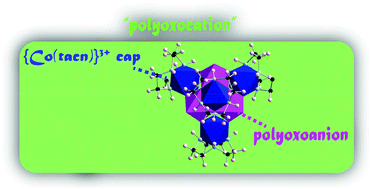Synthesis of cationic molybdenum–cobalt heterometallic clusters protected against hydrolysis by macrocyclic triazacyclononane complexes†
Abstract
Four kinds of cobalt–polyoxomolybdenum clusters were synthesized by a combination of polyoxomolybdates and a Co-tacn (tacn = 1,4,7-triazacyclononane) complex. The heterometallic polynuclear clusters were obtained by the reaction of Na2MoO4 and [Co(tacn)(H2O)3](CF3SO3)3·H2O in water. The peripherals of polyoxomolybdates are capped by thermodynamically stable [Co(tacn)]3+ protecting groups to prevent further hydrolysis and condensation reactions. Intra-molecular hydrogen bonds between N–H groups on tacn and oxygen atoms on the molybdate core contribute to the stability of the complexes in water. Under the optimized synthetic conditions, the molar ratios of Na2MoO4 and [Co(tacn)(H2O)3](CF3SO3)3·H2O were adjusted to 1 : 0.3, 1 : 0.9, or 1 : 1.5, producing [{Co(tacn)}2Mo3O12]·2NaCF3SO3·7H2O (1), [{Co(tacn)}4H2Mo7O27](CF3SO3)2·13H2O (2), and [{Co(tacn)}4H3Mo4O17](CF3SO3)5·6H2O (3), respectively. As one of the most important factors, the adjustments of the pH values by changing the molar ratio enabled us to isolate these clusters. The presence of pyridine produces a neutral complex, [Co2(tacn)2(pyridine)Mo5O18]·4.5H2O (4) containing a lacunary Lindqvist-type polyoxomolybdate. The synthesis of complexes 2–4 is also possible starting from cluster 1, implying that 1 is a precursor for the formation of 2–4 in aqueous solution. Complexes 2–4 have a common structural building block, [{Co(tacn)}2Mo3O13], in each of the cluster units. The 1H NMR spectra of 2 and 3 in aqueous solution show multiple splitting patterns of methylene signals on tacn ligands according to the chemical environments indicated by the crystallographic structure. The 59Co NMR spectrum of cluster 3 in CH3NO2 has two signals from two different Co units with a 3 : 1 integration ratio ensuring the structural integrity in solution. The broadening of one of the signals for the 59Co NMR spectrum of cluster 3 in water as a protic solvent reveals the presence of the deprotonation equilibrium of the acidic protons on the cluster framework in water.



 Please wait while we load your content...
Please wait while we load your content...